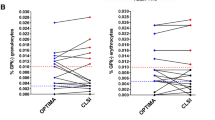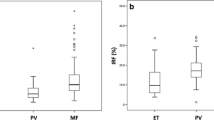Abstract
Minor populations of glycosylphosphatidylinositol-anchored protein-deficient (GPI[−]) cells in the peripheral blood may have a prognostic value in bone marrow failure (BMF). Our objective is to establish the optimal flow cytometry (FCM) assay that can discriminate GPI(−) populations specific to BMF from those of healthy individuals. To identify a cut-off that discriminates GPI(−) rare cells from GPI(+) cells, we determined a position of the borderline that separates the GPI(−) from GPI(+) cells on a scattergram by testing more than 30 healthy individuals, such that no GPI(−) dot fell into the upper left quadrant where fluorescein-labeled aerolysin (FLAER)−CD11b+ granulocytes and CD55−CD59− glycophorin A+ erythrocytes were positioned. This method allowed us to define ≥ 0.003% CD11b+FLAER− granulocytes and ≥ 0.005% glycophorin A+CD55−CD59− erythrocytes to be specific to BMF patients. Longitudinal cross-validation studies showed minimal (< 0.02%) inter-laboratory differences in the GPI(−) cell percentage. An analysis of 1210 patients with BMF revealed a GPI(−) cell population in 56.3% of patients with aplastic anemia and 18.5% of patients with myelodysplastic syndrome. The GPI(−) granulocyte percentages was 0.003–0.01% in 3.7% of patients. This FCM assay effectively identified an increase in the percentage of GPI(−) rare cells that are specific to BMF patients and allowed different laboratories to accurately detect 0.003–0.01% of pathological GPI(−) cells.




Similar content being viewed by others
References
Dunn TE, Tanawattanacharoen P, Boccuni P, Nagakura S, Green SW, Kirby MR, Kumar MS, Rosenfeld S, Young NS (1999) Paroxysmal nocturnal hemoglobinuria cells in patients with bone marrow failure syndromes. Ann Intern Med 131:401–408
Maciejewski JP, Rivera C, Kook H, Dunn D, Young NS (2001) Relationship between bone marrow failure syndromes and the presence of glycophosphatidyl inositol-anchored protein-deficient clones. Br J Haematol 115:1015–1022
Sugimori C, Mochizuki K, Qi Z, Sugimori N, Ishiyama K, Kondo Y, Nakao S (2009) Origin and fate of blood cells deficient in glycosylphosphatidylinositol-anchored protein among patients with bone marrow failure. Br J Haematol 147(1):102–112
Hosokawa K, Sugimori N, Katagiri T, Sasaki Y, Saito C, Seiki Y, Mochizuki K, Yamazaki H, Takami A, Nakao S (2015) Increased glycosylphosphatidylinositol-anchored protein-deficient granulocytes define a benign subset of bone marrow failures in patients with trisomy 8. Eur J Haematol 95:230–238
Kulagin A, Lisukov I, Ivanova M, Golubovskaya I, Kruchkova I, Bondarenko S, Vavilov V, Stancheva N, Babenko E, Sipol A, Pronkina N, Kozlov V, Afanasyev B (2014) Prognostic value of paroxysmal nocturnal haemoglobinuria clone presence in aplastic anaemia patients treated with combined immunosuppression: results of two-centre prospective study. Br J Haematol 164:546–554
Maciejewski JP, Follmann D, Nakamura R, Saunthararajah Y, Rivera CE, Simonis T, Brown KE, Barrett JA, Young NS (2001) Increased frequency of HLA-DR2 in patients with paroxysmal nocturnal hemoglobinuria and the PNH/aplastic anemia syndrome. Blood 98:3513–3519
Narita A, Muramatsu H, Sekiya Y, Okuno Y, Sakaguchi H, Nishio N, Yoshida N, Wang X, Xu Y, Kawashima N, Doisaki S, Hama A, Takahashi Y, Kudo K, Moritake H, Kobayashi M, Kobayashi R, Ito E, Yabe H, Ohga S, Ohara A, Kojima S, Japan Childhood Aplastic Anemia Study Group (2015) Paroxysmal nocturnal hemoglobinuria and telomere length predicts response to immunosuppressive therapy in pediatric aplastic anemia. Haematologica 100:1546–1552
Sugimori C, Chuhjo T, Feng X, Yamazaki H, Takami A, Teramura M, Mizoguchi H, Omine M, Nakao S (2006) Minor population of CD55-CD59- blood cells predicts response to immunosuppressive therapy and prognosis in patients with aplastic anemia. Blood 107:1308–1314
Wang H, Chuhjo T, Yasue S, Omine M, Nakao S (2002) Clinical significance of a minor population of paroxysmal nocturnal hemoglobinuria-type cells in bone marrow failure syndrome. Blood 100:3897–3902
Araten DJ, Nafa K, Pakdeesuwan K, Luzzatto L (1999) Clonal populations of hematopoietic cells with paroxysmal nocturnal hemoglobinuria genotype and phenotype are present in normal individuals. Proc Natl Acad Sci U S A 96:5209–5214
Hu R, Mukhina GL, Piantadosi S, Barber JP, Jones RJ, Brodsky RA (2005) PIG-A mutations in normal hematopoiesis. Blood 105:3848–3854
Borowitz MJ, Craig FE, Digiuseppe JA, Illingworth AJ, Rosse W, Sutherland DR, Wittwer CT, Richards SJ (2010) Clinical Cytometry Society. Guidelines for the diagnosis and monitoring of paroxysmal nocturnal hemoglobinuria and related disorders by flow cytometry. Cytometry B Clin Cytom 78:211–230
Dalal BI, Khare NS (2013) Flow cytometric testing for paroxysmal nocturnal hemoglobinuria: CD64 is better for gating monocytes than CD33. Cytometry B Clin Cytom 84:33–36
Tutelman PR, Aubert G, Milner RA, Dalal BI, Schultz KR, Deyell RJ (2014) Paroxysmal nocturnal haemoglobinuria phenotype cells and leucocyte subset telomere length in childhood acquired aplastic anaemia. Br J Haematol 164:717–721
Perfetto SP, Chattopadhyay PK, Roederer M (2004) Seventeen-colour flow cytometry: unravelling the immune system. Nat Rev Immunol 4:648–655
Katagiri T, Kawamoto H, Nakakuki T, Ishiyama K, Okada-Hatakeyama M, Ohtake S, Seiki Y, Hosokawa K, Nakao S (2013) Individual hematopoietic stem cells in human bone marrow of patients with aplastic anemia or myelodysplastic syndrome stably give rise to limited cell lineages. Stem Cells 31:536–546
Sutherland DR, Keeney M, Illingworth A (2012) Practical guidelines for the high-sensitivity detection and monitoring of paroxysmal nocturnal hemoglobinuria clones by flow cytometry. Cytometry B Clin Cytom 82:195–2008
Sutherland DR, Kuek N, Davidson J, Barth D, Chang H, Yeo E, Bamford S, Chin-Yee I, Keeney M (2007) Diagnosing PNH with FLAER and multiparameter flow cytometry. Cytometry B Clin Cytom 72:167–177
Wang SA, Pozdnyakova O, Jorgensen JL, Medeiros LJ, Stachurski D, Anderson M, Raza A, Woda BA (2009) Detection of paroxysmal nocturnal hemoglobinuria clones in patients with myelodysplastic syndromes and related bone marrow diseases, with emphasis on diagnostic pitfalls and caveats. Haematologica 94(1):29–37
Acknowledgments
We thank all participating physicians and registered patients who took part in this study.
Funding
Research fund from Alexion.
Author information
Authors and Affiliations
Contributions
KH, CS, HN, TS, NO, YS, YN, YU, YY, and TK performed the research; TS, SC, HN, KA, YY, and TK collected patients’ samples. KI and HT collected samples from healthy volunteer. CS, JN, YK and SN designed the study; KH, CS, and SN wrote the paper.
Language check, by an independent medical writer, Caroline Dunstall, was provided by Alexion.
Corresponding author
Ethics declarations
All human subjects were collected after obtaining written informed consent for their participation in accordance with the Declaration of Helsinki through clinical protocols approved by the Institutional Review Board.
Conflicts of interest
Dr. Ninomiya, Dr. Shichishima, Dr. Yonemura, Dr. Kawaguchi, and Dr. Nakao report personal fees from Alexion Pharma G.K., outside the submitted work; Dr. Ninomiya, Dr. Chiba, Dr. Ueda, Dr. Yonemura, and Dr. Nakao report grants from Alexion Pharma G.K., outside the submitted work; Dr. Kanakura and Dr. Nishimura report grant and personal fees from Alexion Pharma G.K. during the conduct of the study; Dr. Shirasugi report honoraria from Novartis; Dr. Hosokawa, Dr. Sugimori, Dr. Ishiyama, Dr. Takamatsu, Dr. Noji, Dr. Obara, Dr. Nakamura, and Dr. Ando have nothing to declare.
Rights and permissions
About this article
Cite this article
Hosokawa, K., Sugimori, C., Ishiyama, K. et al. Establishment of a flow cytometry assay for detecting paroxysmal nocturnal hemoglobinuria-type cells specific to patients with bone marrow failure. Ann Hematol 97, 2289–2297 (2018). https://doi.org/10.1007/s00277-018-3443-1
Received:
Accepted:
Published:
Issue Date:
DOI: https://doi.org/10.1007/s00277-018-3443-1




